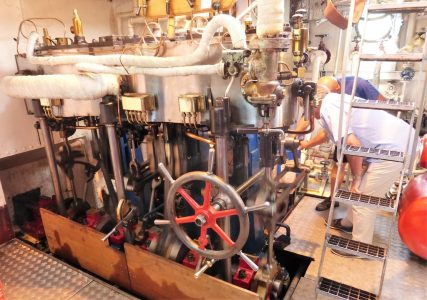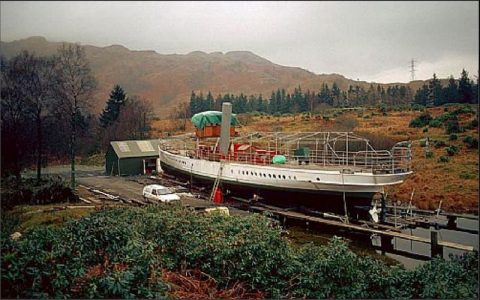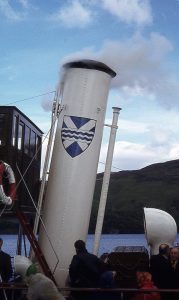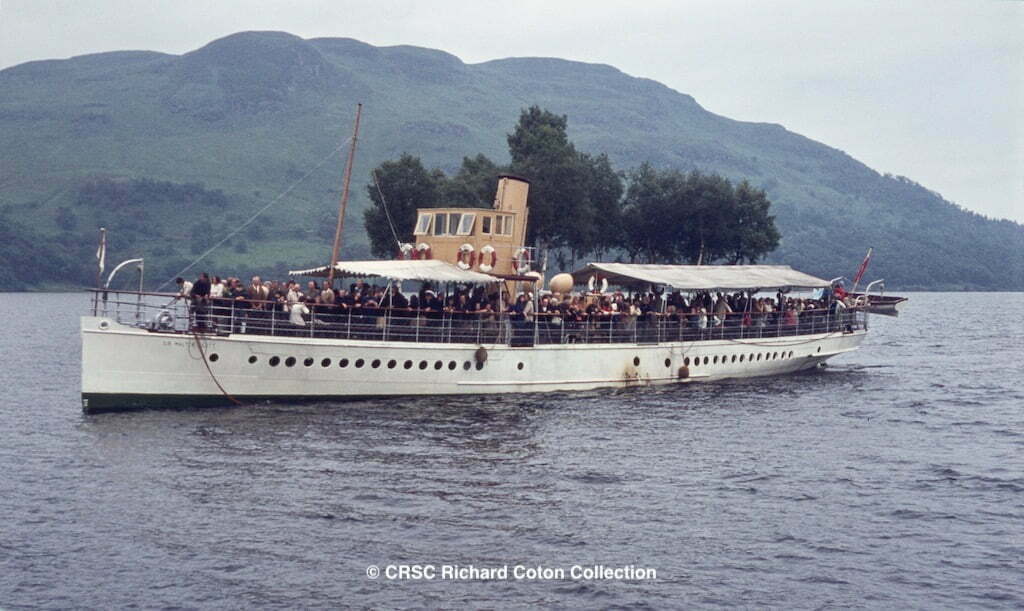
Half a century ago: Sir Walter Scott arrives at Stronachlachar in July 1972, still identifiably a Victorian steamship
John Beveridge tells the story of Scotland’s oldest steamship, and takes heart from her owners’ determination to return her to service.
How times change. When a new steamship was launched on the banks of Loch Katrine in 1899, she was named after the Scottish novelist, poet and historian Sir Walter Scott (1771-1832), whose reputation was at an all-time high. Today, Scott’s novels are out of fashion, and the steamship bearing his name is also in danger of disappearing from the public eye — unless money can be found to get her sailing again.
Sir Walter Scott has been laid up since 2020, when her boilers failed their survey. The charity that owns the vessel has launched an appeal for funds: its attractive website outlines ‘six compelling reasons’ to support her return to service. The fundraising climate may be tough, but this delightful Denny veteran, still of sound constitution, is far too valuable a tourist attraction to be left to languish. For more than a century she has introduced visitors to the timeless beauty of one of Scotland’s most scenic lochs, while adapting herself to the rough-and-tumble of changing circumstances. To survive her latest challenge, she will need our help.
She has a quirky history. Details of her early career are vague, but we know she was ordered on 20 February 1899 by Robert Blair, proprietor of Inversnaid Hotel and the Hotel Trossachs, from Matthew Paul & Co of Dumbarton, who built her triple expansion steam engines and sub-contracted the hull to William Denny & Brothers. The likelihood is that, after construction at the builder’s yard, she was dismantled and taken to Loch Katrine in parts — in much the same way that A. & J. Inglis transported parts of Maid of the Loch from Pointhouse to Balloch for re-assembly and launch there.
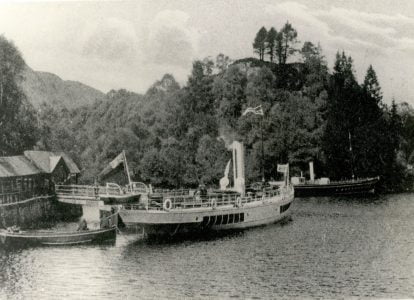
In the beginning: Sir Walter Scott lies at Trossachs Pier in the early 1900s. Note her wheel placed on deck behind the mast, no awnings, and the original square windows on the lower deck. The previous steamer, Rob Roy, is tied up nearby
The most appropriate way of transporting the hull to Loch Katrine would have been by taking it in sections to Balloch, then by barge or puffer up Loch Lomond as far as Inversnaid. The nature of the steep and twisty road from Inversnaid to Stronachlachar would mean the hull could only have been dragged up and over the hill in sections by teams of horses, as it would have been impossible to pull the entire hull up and round the bends in the road.
Legend has it that horses from the Inversnaid stables were fitted with leather shoes to provide a better grip when hauling the various components up the incline. Transportation from barge to shore and up the hill must have been quite a spectacle. The engine and boilers would have been sent by rail and road via Callander.
At Stronachlachar the hull was rebuilt, the engines and boilers inserted, the propeller fitted, and the decking added. Sir Walter Scott was finally launched on 31 October 1899. The Denny Tank in Dumbarton holds records of her trials, which were carried out on a temporary measured mile on Loch Katrine on 3 May 1900, when she attained a speed of 9.96 knots. She was registered in Glasgow on 6 June 1900, so presumably public sailings commenced soon after.
A single screw vessel, she has a length of 110 feet (33.5m), draught of 4’ 1” (1.25m), and gross tonnage of 115. As built she was powered by twin locomotive coal-fired boilers, working at 160psi. She could carry 540 passengers. A male and a female toilet (originally earth closets) were located on the lower deck aft, while a shop/tearoom and captain’s cabin were in the forward lower space. From the start, sewage was retained on board and pumped ashore, as Loch Katrine is a reservoir.

Approaching Stronachlachar in 1947 with open bridge and still with square windows (© Bill Lind Collection/Ballast Trust)
Until 2020, Sir Walter Scott sailed ever summer except for the two World Wars — though she did perform some sailings early in 1940 in preparation for possible enemy paratrooper landings.
Her original managing owner, Robert Blair, was succeeded by other local hoteliers. In 1936 the Loch Katrine Steamboat Company was formed to operate her (latterly trading as Eglinton Hotels Ltd).
Glasgow Corporation, meanwhile, had been buying up all the available land and houses in the area, in order to protect the catchment of the reservoir. In September 1952 the last piece of land – the area where the pier is located – came up for sale and the Corporation purchased it from Eglinton Hotels, along with the steamer and navigation rights.
In 1969 the Lower Clyde Water Board (LCWB) was created to own and operate all drinking water and sewage treatment facilities. As Sir Walter Scott was on a reservoir, ownership passed to the LCWB. As a result of local government reorganisation in 1975, the LCWB was superseded by Strathclyde Regional Council (SRC); then in 1996 by the West of Scotland Water Authority; then again in 2002 by Scottish Water. These changes were merely paper transfers, and the staff remained the same.
In 2003-04 the independent Water Commissioner decreed that Scottish Water must dispose of all its non-core business — including Sir Walter Scott. This put her future in doubt, but a high-profile publicity campaign led to an agreement under which vessel and infrastructure passed to The Steamship Sir Walter Scott Trust, formed on 6 April 2005.

Sir Walter Scott at Trossachs Pier in her post-1967 condition of buff funnel, plain awnings and green boot topping. The windows had been replaced by portholes in 1954
The ship has undergone many alterations over the years. Photographs dated 1900 and 1901 show no awnings over the deck to shelter passengers. Later photographs show a covering over the aft deck. The position of the helmsman was changed from behind the mast on the main deck, to an open platform just forward of the funnel: passengers must have been getting in the way of the helmsman’s view! Exactly when this happened is not clear, but a photograph dated 1908 shows the platform enclosed by canvas railings to waist height, giving her an open bridge (like Clyde steamers of the time). In 1926 she was reboilered by her original boilermakers, Marshall & Anderson of Motherwell.
After the Second World War, Sir Walter Scott was apparently in a very poor condition. In photographs dated 1939/40 she has an open wheelhouse, but one dated March 1949 shows an enclosed wooden wheelhouse, so it is likely that the enclosed wheelhouse was fitted around 1948 (again in keeping with Clyde steamers at the time).
In early January 1954, a fire smouldered on board all night in the aft cabin, causing serious damage. Scotts of Bowling carried out the repairs: their drawings, dated March of that year, show the original square windows in the hull and a lifesaving capacity of 423 (416 passengers and 7 crew). It was at this time that the lower saloon windows were replaced by the portholes we know today.
Two years later she was again reboilered, this time with a pair of welded boilers supplied by Marshall & Anderson, and a new funnel was built.
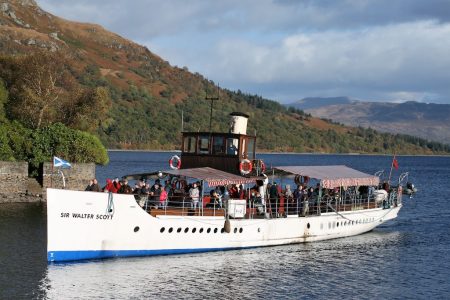
Arriving at Stronachlacher in 2007 with blue boot-topping and a new bow — ‘not in keeping with a Victorian steamship’
In 1967 smokeless coal was introduced, while in 1973 the LCWB changed the funnel colour from buff to white, with their logo in blue. When SRC took over, the funnel remained all white but minus the logo. By 1980, her passenger certificate had been reduced to 350, and following the Marchioness disaster in 1989 it was further reduced to 320. Four inflatable liferafts were fitted in 1986.
A DTI survey in 1990 revealed the need for new boilers, and during the following winter Sir Walter Scott was fitted with twin Cochran boilers at a cost of £75,000. In 1991 she appeared with “S.S. Sir Walter Scott” emblazoned on her bows.
Moving on to the winter of 1997-98, her machinery was removed and overhauled in the Waverley Excursions Ltd workshop by Waverley’s engineers. The following year the lifeboat which had been slung over the stern was replaced by an inflatable MOB boat (Man Over Board) hung in davits.
As part of the deal to establish The Steamship Sir Walter Scott Trust in 2005, £85,000 was made available for immediate repairs — revealing that the vessel was structurally in very poor condition. A rescue package of £2.2m was put together over the next two years by Scottish Water and the Scottish Government. This enabled the Trust to embark on a three-phase rebuild.
Phase 1 involved the rebuilding of the forward section, with virtually a new bow incorporating a bow thrust — though the new bow looked distinctly odd and not in keeping with a Victorian steamship.
Under Phase 2 in 2008, two new ‘Wee Chieftain’ boilers from Cochran were fitted, and the change was made from coal-fired to oil and biofuel.
Phase 3 the following year produced the biggest visual change, with the addition of a large deckhouse. The Trust’s justification for this was the complete lack of covered accommodation on deck, adversely affecting the potential for attracting coach parties and charter groups, which expected shelter from Scotland’s unpredictable weather. It also wanted to provide a small tea bar on deck and a disabled toilet.
These alterations reduced the ship’s passenger certificate to 245. Her bow was altered back to its original profile, a welcome move.
Just as the ship had changed in appearance, her business model needed to adapt to the wider shifts in the leisure trade. For much of her career Sir Walter Scott had a captive market. In the early 20th century the Caledonian Railway (to Callander) and the North British Railway (to Aberfoyle) provided a constant stream of people keen to sample the Trossachs. The famous ‘Tour No 1’ incorporated sailings on Loch Katrine and Loch Lomond, with various options for travelling by train to or from Edinburgh/Glasgow, then by coach to Trossachs pier, Sir Walter Scott to Stronachlachar, coach (originally horse drawn carriage) to Inversnaid, then steamer to Balloch and return by train. The tour could also be done in reverse. Aberfoyle station closed in 1951, Callander in 1965, and the Loch Lomond connection ceased in 1981. By the 1950s coach parties were providing most of the passengers. These averaged around 68,000 in 1970 and topped 89,000 in 2004.
Advertising was minimal, the timetable being printed on one sheet of coloured paper which did not change in style or content from the 1950s to 1979. In 1980 a drawing of the ship appeared, along with a location map. In 1986 DayGlo paper was used, and from 2000 coloured leaflets with photographs and proper maps started to promote the historic ship and scenery. Former staff have said that advertising was not needed as passenger numbers remained high because of the substantial number brought by coach tour operators.
With the advent of the Trust in 2005, a whole new approach was adopted. The Trust has diversified, invested and been proactive in marketing and advertising. For the 2006 season a second vessel was purchased — Ellen’s Isle (ex Maid of the Tay), capable of taking 30 passengers for short cruises all year round, while Sir Walter Scott now had a morning return trip to Stronachlachar and five 45-minute cruises, eventually tying up at 7pm.
This combination proved so successful that, for the 2008 season, another vessel was acquired — Lady of the Lake (ex Pride O’ the Clyde, ex Stad Monnickendam). Taking 80 passengers, she gave seven 45-minute cruises and took on the early and late season 10.30 Stronachlachar sailings, which continued through the winter.
In 2009 Ellen’s Isle was spare vessel while Sir Walter Scott continued as before. Lady of the Lake gave three one-hour cruises and the afternoon return to Stronachlachar. Winter sailings ceased, but in 2015 Sir Walter Scott’s season was extended to cover Christmas and New Year cruises. These ‘Sail with Santa’ and New Year celebration cruises proved so popular that they have become a fixture. Following the withdrawal of Sir Walter Scott in 2020, the Trust purchased the Ulva ferry Sula Beag (1985) and, after conversion work, renamed her Rob Roy III for the 2021 season.
As well as the cruises, the Trust generates income from indoor and outdoor cafes, gift shop, cycle hire, eco lodges and campervan stays. Promotions have included packages for a one-way cruise and cycle return; meal and cruise; afternoon tea and cruise; weddings and other special events. In 2018, more than 70,000 passengers were carried.
Thankfully, the Trust believes in a future for Sir Walter Scott and, banishing thoughts of ‘dieselisation’, has agreed to commission two new steam boilers from Byworth Boilers Ltd. It has set an appeal target of £500,000, stressing the ship’s heritage and educational value as well as her tourist appeal. In anticipation of achieving this, the old boilers have been cut up and removed. It is hoped this Victorian gem of a steamship will sail again soon.
My thanks to The Steamship Sir Walter Scott Trust, the Denny Tank Museum and Craig Osborne for assisting with information.
Click here to make a donation to the Sir Walter Scott appeal. Loch Katrine sailing schedule: www.lochkatrine.com

A deck scene in June 1974, looking aft along the port side with Captain John Fraser chatting to passengers
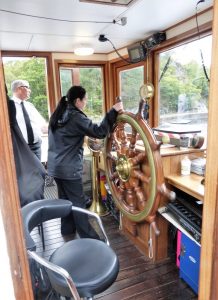
Sir Walter Scott’s wheelhouse in 2014, with Captain Debbie Whyte and general manager Gordon Allan. The original Mechans telegraph is to the left of the wheel

Sir Walter Scott approaching Trossachs Pier in 2014, with Ben Venue as a backdrop. The scenery around Loch Katrine is spectacular, and tourists never cease to be amazed
Click here to donate to the Sir Walter Scott appeal.
Published on 20 January 2022












